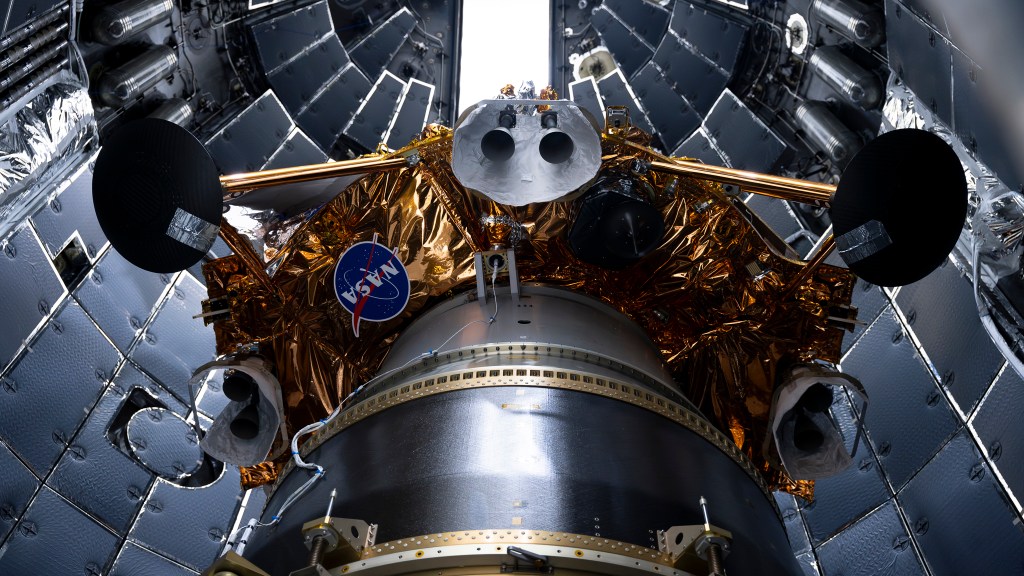DTN Resources for Mission Development
The Science Mission Directorate (SMD) worked with representatives from NASA’s science mission community to identify and validate the benefits of Delay/Disruption Tolerant Networking (DTN) for flight projects (see PDF below for the white paper). DTN can benefit all types of missions. It is currently being used operationally by scientific payloads on the International Space Station as well as systems vital to the health and safety of the humans on board. It has also been used by Lunar and deep space missions, successfully demonstrating its utility for complex future missions that include multiple landers and relay orbiters, human exploration efforts involving numerous assets on the Moon and Mars, swarms of spacecraft, and scenarios where all mission assets must communicate with each other. In coordination with SMD, the Space Communications and Navigation (SCaN) program is implementing the infrastructure necessary to support communication with upcoming DTN-enabled missions such as Plankton, Aerosol, Cloud, ocean Ecosystem (PACE), the Artemis program’s Gateway, and several CubeSats.
Why Use DTN?
Standardization
- Reuse: Proven DTN hardware, software, and operations procedures could be used by all mission types, reducing or eliminating the frequent implementation of different methods to achieve common mission communications functions
- Interoperability: DTN would provide a standard network layer interface to allow data to be communicated among different systems employing it, including systems belonging to NASA, other government and international agencies, and industry
Networked Communications
- Scalability: DTN can reduce the difficulty of adding a new node, link, or path to a communications network
- Autonomy: Information embedded in the DTN bundle enables data-driven end-to-end data delivery across multiple hops
- Independent Link Evolution: DTN allows the process of data transport to be decoupled from underlying links, facilitating upgrades to the links
“Store-and-forward” Communications Approach enables
- Networking with Delays: DTN enables data delivery across an end-to-end path based on destination address, even when the end-to-end path between source and destination includes extreme communication delays
- Networking with Disconnections: DTN enables data delivery across an end-to-end path based on destination address, even when a full bandwidth end-to-end path between source and destination does not always exist for the duration of a communication session
- Networking with Data Rate Mismatches: DTN enables data delivery across an end-to-end path based on destination address, even when sequential nodes on the path transmit data at different rates
- More Efficient Use of Bandwidth and Contact Times: DTN’s ability to provide data delivery across an end-to-end path even when the full bandwidth end-to-end path between source and destination does not always exist enables efficient use of bandwidth and contact time
- Simplified Flight and Ground System Implementations and Operations: DTN enables simpler solutions to meet mission requirements
DTN Standards
- CCSDS Bundle Protocol Specification – Recommended Standard that defines a CCSDS Bundle Protocol based on the Bundle Protocol of RFC 5050, with necessary extensions to support the Delay/Disruption Tolerant Networking (DTN) of space applications
- IETF DTN page– Provides the latest draft specifications developed by the Internet Engineering Task Force (IETF) DTN Working Group
- CCSDS Space Internetworking Services Area
- Licklider Transmission Protocol (LTP) for CCSDS
- Schedule-Aware Bundle Routing
Software Options
- Core Flight System (cFS)
- A flight software architecture consisting of a set of mission independent, re-usable, core flight software services, applications, and operating environment. Latest release includes an implementation of Delay/Disruption Tolerant Networking (DTN) Bundle Protocol that will be used by the PACE and Lunar IceCube missions
- OpenSatKit* – Provides an open source desktop solution for learning how to use cFS
- DTN cFS Software (note: Software use may be subject to terms and restrictions per NASA Open Source Agreement [NOSA] license)
- BP app – Application that implements DTN into cFS
- Bundle Protocol Library – Enables use of the cFS BP app by encapsulating/extracting application data in/out of bundles. Can also be used by non-cFS missions
- Interplanetary Overlay Network (ION)
- The Interplanetary Overlay Network (ION) software distribution is an implementation of Delay-Tolerant Networking (DTN) architecture, as described in Internet RFC 4838, and developed by the Jet Propulsion Laboratory. It is a DTN Suite that supports multiple operating systems and CPU architectures and can be used in constrained both flight system environments with strict memory management and ground operations systems. While ION’s initial development targeted deep space missions, it has also been used in both near-Earth and terrestrial applications, including:
- The International Space Station and several of its scientific payloads (e.g., ECOSTRESS, Cold Atom Lab), where ION performs daily relay operations of science data from the payload to the ground. Currently, ION bpv6 is part of the MSFC TReK Toolkit for ISS payload developers.
- The Deep Impact Spacecraft, where ION was infused as a technology demonstrator and successfully demonstrated BP and LTP.
- The Lunar IceCube spacecraft, which flew on the ARTEMIS-1 mission.
- The Deep Space Network (DSN), where ION will be used as the DTN implementation of choice to support all spacecraft using the DSN, including BP, LTP and BPSec.
- The 21m antenna at Morehead State University, associated with the DSN, which deployed ION nodes to support the Lunar IceCube spacecraft.
- The NSN ground system BPN-GND is based on ION and will be used to support the PACE mission.
- The ION implementation contains the following operational capabilities:
- BPv7 and BPv6, including generation, forwarding, routing and delivery to applications.
- Support for multiple convergence layers, including STCP, UDP and LTP. For the latter, transfer rates up to ~4 Gbps have been demonstrated in the lab.
- Support for the CCSDS File Delivery Protocol (CFDP) (standalone, or over BP).
- Support for BPSec.
- Support for the Asynchronous Messaging System, a pub/sub mechanism on top BP.
- Routing using the Schedule-Aware Bundle Routing.
- DTN-AMP for ION Node network management and control
- An AMMOS product called ANMS as a GUI for ION Network Manager workstations.
- Utilities and applications testing, debugging (e.g., bping, bpecho) and configuring ION nodes.
- PyION, a python interface to facilitate working with ION for the purpose of testing, V&V and development of ground data systems.
- Additionally, ION contains several applications in development that can be used to augment the operation of the DTN node and network. These include:
- The Bundle Streaming Service (BSS) library supports streaming of data for display in transmission order as received in real time, while storing all data, including out-of-order retransmitted data, in a private database for later reconstruction of the data stream without missing data.
- BSSP, a convergence layer protocol that transmits data via two channels, one reliable and another unreliable, for consumption of streaming data in real-time (possibly with gaps) or after-the-fact (without any gaps). It is typically used in conjunction with BSS for streaming video over DTNs.
- DTKA, a delay-tolerant key administration system for public key infrastructure (PKI) in DTNs.
- DTPC, an application service protocol to provide an application with streaming data in transmission order, with latency added for retransmission of missing data as required to insure in-order delivery to an application. DTPC also may provide application-controlled elision of redundant data items in aggregated payloads, to improve link utilization.
- JSYNC, an application built on top of ION for file synchronization similar in function to RSYNC. It was demonstrated by NASA in Desert Rat exercises.
- The following list contains resources and documentation for ION:
- ION course videos and presentations
- ION SourceForce Repository
- PyION GitHub repository, documentation, and Docker images
- DTN Development/Deployment Kit (1.7 GB Download)* – An ISO image of an Ubuntu virtual machine, pre-configured with ION and a GUI virtualization environment. Contains a number of pre-built scenarios (network topologies) to demonstrate various features of ION.
- Ground software:
- ITOS – A satellite telemetry and command system that includes a DTN implementation incorporating some ground station or MOC interfaces with ION
- BPN-GND – A generic node solution for development labs, integration facilities, ground stations, and mission operation centers (Available upon request)
- DTN Marshall Enterprise (DTNME)
- A CCSDS-compliant implementation that is designed to be an enterprise class software solution with the ability to operate in high-performance environments. DTNME is fully capable of supporting up to 400Mbps of DTN downlink from the ISS. DTNME has been run successfully on Redhat Enterprise Linux, Ubuntu, and Debian.
- DTNME on GitHub* – Provides the latest release of DTNME (open source)
- DTNME Features:
- Supports Simultaneous use of both the BPv6 and BPv7 protocols
- Bundle in Bundle Encapsulation – Can be used to encapsulate BPv6 bundle in BPv7 bundles
- Aggregate Custody Signal
- Licklider Transport Protocol
- CCSDS File Delivery Protocol
- TCL Console Interface
- DTN Simplified API
- High-rate Delay Tolerant Networking (HDTN)
- HDTN is a performance optimized implementation of the DTN standard, which targets applications involving high-rate RF and optical links. HDTN features the follow attributes:
- BPv7 protocol, bundle generation and termination, storage, scheduling, link status, routing and a web interface
- Rates exceeding Gbps may be achieved on supporting platforms
- Singular and distributed implementations have been tested on Intel, AMD & ARM architectures
- Interoperability tested with DTNME, ION and microDTN
- Currently HDTN is targeting several mission infusion opportunities, such as:
- ISS upgrades to support enhanced operations and laser communications payloads such as Integrated LCRD Low-Earth Orbit User Modem and Amplifier Terminal (ILLUMA-T)
- Cloud-based implementations to support optical ground terminals for the Laser Communications Relay Demonstration (LCRD) mission
- Multiprocessor architecture implementations to support small satellite hyperspectral imaging applications
- Pursuing NASA Procedural Requirement NPR 7150.2 (NASA Software Engineering Requirements) compliance to support Artemis missions.
- HDTN is a performance optimized implementation of the DTN standard, which targets applications involving high-rate RF and optical links. HDTN features the follow attributes:
- Resources for HDTN:
- HDTN on GitHub: provides the latest release of HDTN (open source) along with a user guide
- Video Tutorial: HDTN Community Day – Running and Configuring the Product
- Latest publications and development news

























